Excerpts from Jim Conrad's
Naturalist Newsletter
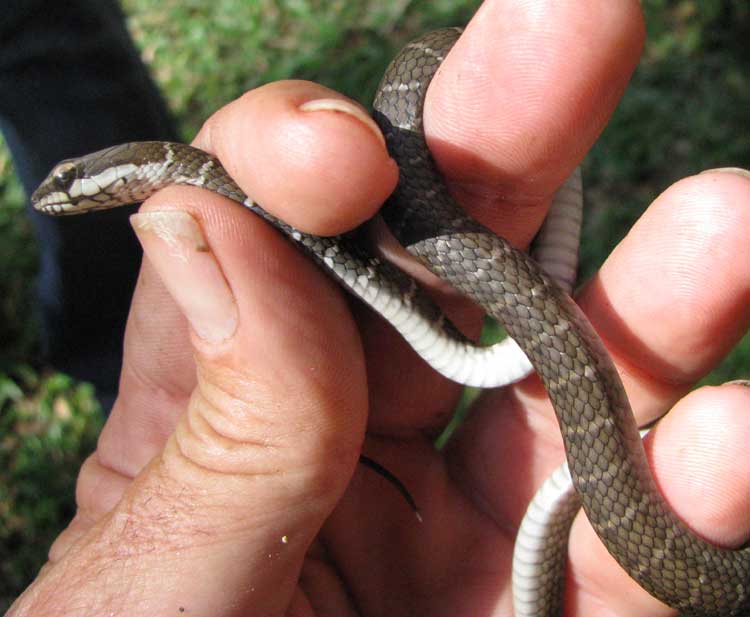
from the February 6, 2011 Newsletter issued from Hacienda Chichen Resort beside Chichén Itzá Ruins, central Yucatán, MÉXICO; limestone bedrock, elevation ~39m (~128ft), ~N20.676°, ~W88.569°
A MIDDLE AMERICAN SMOOTH-SCALED RACER*
Since head-scale patterns are so important in snake identification I took the head-top picture shown below:
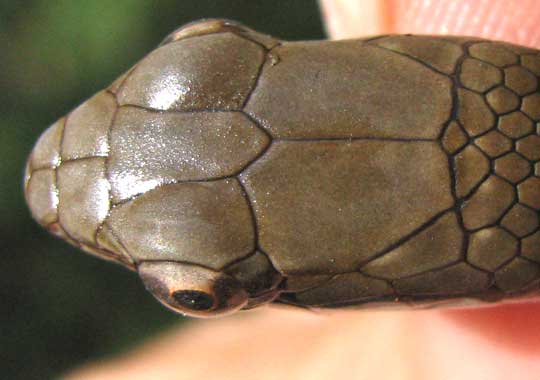
As well as the shot of the side of the head seen below:
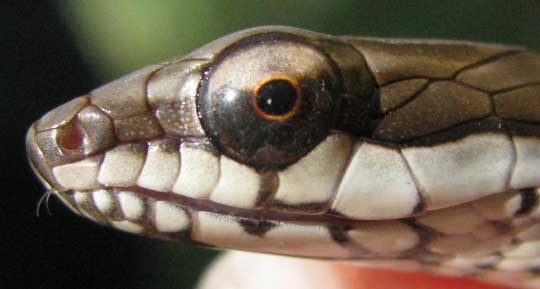
It was a Middle American Smooth-scaled Racer, DRYADOPHIS MELANOLOMUS, a species less likely to have fallen from a tree than to have tumbled into the pool and been unable to escape. The species is considered a denizen of the forest floor.
Back in 2006 I ran across this same species behind a potted plant on a patio near Telchac Pueblo 56 air-miles (90km) northwest of here. {See section below.} That picture shows a snake that's basically dark red, while our snake is grayish brown. It turns out that the species comes in several color variations. Jonathan Campbell in his Amphibians and Reptiles of Northern Guatemala, the Yucatán, and Belize remarks that in Guatemala he's seen olive-brown and deep reddish orange phases occurring side by side. That's unusual because sympatric races generally interbreed and blend. No one knows what's going on here -- what's keeping the color phases distinct. Whatever is happening, now we can report something similar in the Yucatán. Someday a graduate student someplace in the world will be tickled to read these words.
This species mostly feeds on other reptiles, especially lizards, as well as reptile eggs, frogs and sometimes small rodents.
Issued on September 23, 2019 from near the forest just west of Tepakán; elev. ~9m (~30 ft), N21.053°, W89.052°; north-central Yucatán state, MÉXICO
HEAD SCALES ON A DIFFERENT INDIVIDUAL
A slender, brown snake about 20 inches long (50cm) passed before the hut's door. When I eased around the door's corner, the snake had climbed up the hut's stone wall, and was eyeing me from a chink in the wall, shown below:
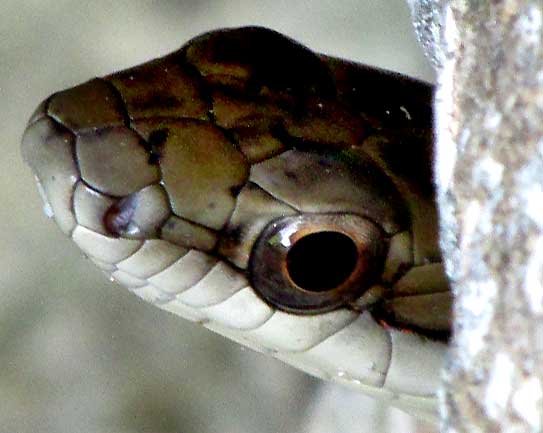
Eventually he started looking around, and I got the following shot of scales atop his head:
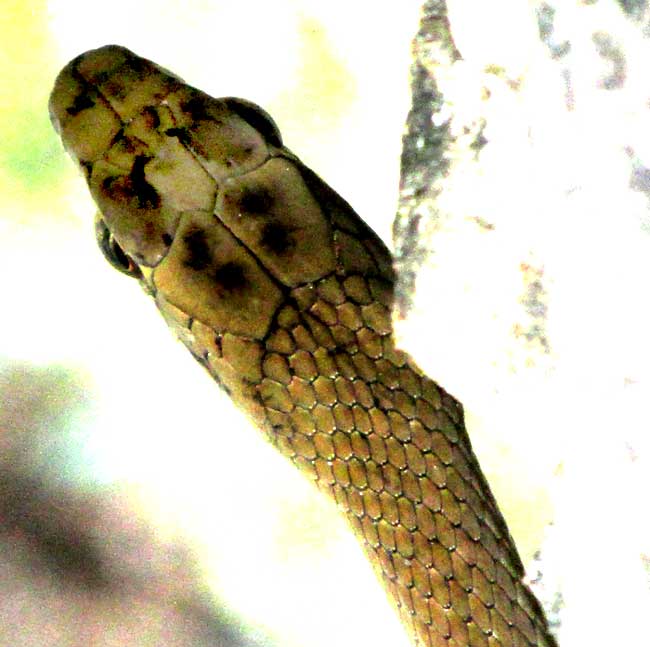
It's interesting to compare the minor differences in scale shape. This individual is found about an hour by car west of the previous individual, at Chichén Itzá.
from the March 18, 2006 Newsletter issued from Hacienda San Juan near Telchac Pueblo, northwestern Yucatán, MÉXICO
A REDDISH RACE OF MIDDLE AMERICAN SMOOTH-SCALED RACER
It's been a good week for reptiles. One morning back at the hacienda Darwin approached wearing his snake-at-the-big-building smile so off I went to see what it was this time. It was a slender, reddish, big-eyed species about two feet long, its body encircled by numerous narrow, pale bands, and it was hiding behind a potted plant on the patio at ground level. At first glance it looked like a coral snake, but it didn't have the right head markings. That's it below.

My herp field-guide by Jonathan Campbell identified it as the Neotropical Racer, MASTIGODRYAS MELANOLOMUS. It's not too closely related to North American racers, which belong to the genus Coluber. They do share the smooth scales typical of northern racers, however, and are just as eager to bite as any cornered northern racer.
Thank's to Vladamir's digital camera I'm especially glad to be able to post this snake's image because it comes in different basic colors, from olive-tan to reddish brown to reddish orange, like ours.
from the April 4, 2011 Newsletter issued from Hacienda Chichen Resort beside Chichén Itzá Ruins, central Yucatán, MÉXICO; limestone bedrock, elevation ~39m (~128ft), ~N20.676°, ~W88.569°
BUG, BASILISK & SNAKE
A little after dawn, before sunlight touched the treetops, I sat reading in front of the hut when a bug plummeted into a lush, knee-high parsley plant beside the door about ten feet away. I wouldn't have even registered the bug if within a second of his descent a Striped Basilisk -- one of those long-tailed, very long-toed lizards who runs on oversized back legs so fast they can stride across open water -- shot from among my Yellow Cosmoses into the parsley, clearly after the bug. Our Striped Basilisk page is at www.backyardnature.net/mexnat/basilisk.htm.
Not a second after the basilisk had plunged into the parsley, a slender, grayish-tan snake over three feet long (±1m) shot from beneath a rock across the garden and dove into the parsley, after the basilisk. In about ten seconds the snake poked his head from the parsley's far side, threaded up through my Cuban Oregano and raised his head looking around. About thirty seconds after the snake entered the oregano the lucky basilisk zipped from the parsley in the opposite direction, but the snake didn't see it. The snake just hung frozen in the oregano for a solid ten minutes not moving a scale, and you can see that lovely sight below:

The snake was a Neotropical Racer, MASTIGODRYAS MELANOLOMUS, commonly seen around here. In fact, in this year's February 6th Newsletter we got some nice pictures of a young one found almost drowned in the fishpond. However, that one was clearly banded, while our present adult shows no body patterns at all. Also, back in 2006 near Telchac Pueblo in northwestern Yucatán we found another young one, which was brightly reddish with weak banding.
So now we have a third color and pattern variation. The species is known to be very variable over its distribution area from northern Mexico to Panama, and now we're seeing stark variations just here in the Yucatán.
The species is known to feed mainly on reptiles, especially lizards, so going for a basilisk that Sunday morning was in order for it.
from the February 4, 2018 Newsletter issued from Rancho Regensis north of Valladolid, Yucatán, MÉXICO;
elevation ~40m (~130 ft), N~20.876°, W~88.170°
RACER BENEATH THE COMPOST
In the garden while rearranging compost I uncovered a little olive-brown snake coiled up and depending on his stillness to make him unnoticeable. I managed to get one shot of him before suddenly he raced off. Below, you can see him, with his head peeping from beneath straw at the picture's lower left:
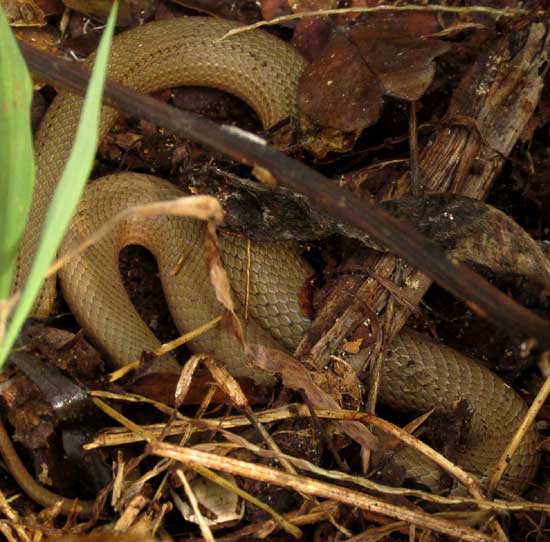
I'd not seen a snake exactly like this -- a brown one with tiny dark spots along the sides hinting of longitudinal striping, smooth scales, and with such bold markings on the face. Except for the face's dark brown markings and those vague dark lines along the body, it looked like a Middle American Smooth-scaled Racer. That's a common species here, and one known to be very variable in appearance. On our page for that species we show a banded immature stage, a surprising reddish, mostly solid-colored form, and a brownish phase looking just like our garden snake, except for our current snake's bold face markings and the dark lines of speckles.
In Jonathan Campbell's Amphibians and Reptiles of Northern Guatemala, the Yucatán, and Belize I read that on the heads of American Smooth-scaled Racers "Usually there is a dark streak across the loreal region from the posterior nasal to the anterior edge of the eye," and that describes our snake's head markings, though on the Internet I don't find the marks so boldly defined. Also, on the Internet only a few pictures show the hints of dark lines running along the body.
Still, with the general shape, the general olive-brown color, the very smooth scales, and what I can see of the head's scales, I'm willing to call this yet another appearance of the Middle American Smooth-scaled Racer. This is a commonly seen snake here and, as Campbell says, "This racer is subject to much individual and ontogenetic variation," "ontogenetic" referring to an individual snake's changing appearance as it develops toward maturity.